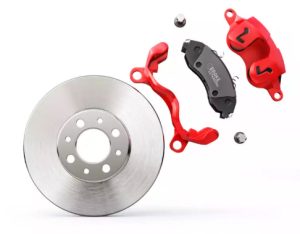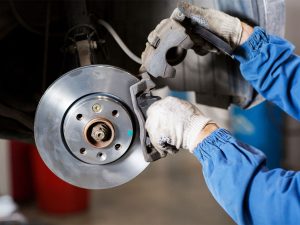When it comes to vehicle safety, few systems are as critical as the brakes. At the core of this system lies the brake caliper — a component that often goes unnoticed but plays an indispensable role in stopping your car. Without a properly functioning caliper, your braking system would fail to deliver the stopping power needed for everyday driving or emergency situations.
This article will explain in detail how brake calipers work, their different types, common problems, and why maintaining them is essential for safe and efficient braking.
What Is a Brake Caliper?

The brake caliper is a key part of a disc brake system. Its primary function is to squeeze the brake pads against the surface of the brake rotor, creating friction that slows down or stops the wheel’s rotation.
Calipers house pistons that are activated hydraulically by brake fluid pressure. When you press the brake pedal, hydraulic pressure is transmitted through the brake lines to the caliper pistons, forcing the pads against the rotor.
How Brake Calipers Work: Step by Step
-
Brake Pedal Pressed – The driver applies pressure to the pedal.
-
Brake Master Cylinder Engages – Brake fluid is pressurized and sent through the brake lines.
-
Hydraulic Pressure Reaches the Caliper – Pistons inside the caliper push outward.
-
Brake Pads Squeeze the Rotor – Friction is created between pads and the rotor.
-
Kinetic Energy Converted to Heat – This heat dissipates through the rotor, slowing the car.
Types of Brake Calipers
Different vehicles and driving conditions use specific caliper designs.
| Type | Description | Advantages | Disadvantages |
|---|---|---|---|
| Floating (Sliding) Calipers | Mounted on pins, move laterally to press pads on both sides of rotor. | Simple design, affordable, lightweight. | Can wear unevenly, more prone to sticking. |
| Fixed Calipers | Bolted directly to the suspension, pistons on both sides press pads simultaneously. | Stronger, more even pad wear, better performance. | More expensive, heavier, complex installation. |
| Single-Piston Calipers | One piston pushes inner pad while caliper slides to engage outer pad. | Low cost, sufficient for daily driving. | Less braking force, uneven wear possible. |
| Multi-Piston Calipers | Two or more pistons distribute force evenly across pad surface. | Better performance, improved heat dissipation, preferred in sports cars. | Higher cost, requires precise maintenance. |
Why Brake Calipers Are the “Heart” of Braking
While brake pads and rotors are the visible parts most drivers think about, calipers are the force multipliers of the system. They translate hydraulic pressure into mechanical clamping force. Without them, brake pads wouldn’t be able to grip the rotor effectively.
Key contributions of calipers include:
-
Consistent stopping power – Balanced clamping force ensures stability.
-
Even pad wear – Especially in multi-piston or fixed calipers.
-
Heat management – Larger calipers help dissipate braking heat.
-
Safety under load – Critical for towing, off-road driving, or high-speed braking.
Common Problems with Brake Calipers
Like any mechanical component, calipers can wear out or fail.
Signs of failing calipers include:
-
Vehicle pulling to one side while braking.
-
Grinding or squealing noises.
-
Brake fluid leaks near wheels.
-
Reduced braking efficiency.
-
Uneven brake pad wear.
| Problem | Cause | Effect on Vehicle |
|---|---|---|
| Sticking Pistons | Corrosion, dirt, or damaged seals. | Brakes drag, reduced fuel efficiency, overheating. |
| Caliper Leaks | Damaged piston seals or hoses. | Loss of hydraulic pressure, dangerous brake fade. |
| Uneven Pad Wear | Seized sliding pins or misaligned caliper. | Reduced braking performance, rotor damage. |
| Overheating | Excessive braking or poor ventilation. | Caliper warping, loss of braking efficiency. |
Maintenance and Replacement Tips
Maintaining brake calipers is crucial to extend their lifespan and keep braking performance at its peak.
Maintenance Checklist
-
Inspect calipers during every brake service.
-
Check for leaks around pistons and hoses.
-
Lubricate sliding pins to prevent sticking.
-
Replace worn seals to avoid leaks.
-
Flush brake fluid every 2 years to reduce corrosion risk.
When to Replace Brake Calipers

-
If the piston is seized and cannot be freed.
-
If caliper housing is cracked or excessively corroded.
-
If brake fluid leaks from the piston area.
-
If braking feels inconsistent or unsafe despite new pads and rotors.
For quality replacements, you can always buy Brake Caliper online to ensure safety and proper fit for your vehicle.
Advantages and Challenges of Modern Brake Calipers
| Advantages | Challenges |
|---|---|
| Strong, reliable braking force. | Costly to replace, especially multi-piston calipers. |
| Available in performance designs for sports cars. | Susceptible to corrosion if neglected. |
| Long service life with proper maintenance. | Require skilled installation and bleeding of brake lines. |
| Wide aftermarket availability. | Overheating possible in extreme conditions. |
Conclusion
Brake calipers are truly the heart of a vehicle’s braking system. They provide the mechanical clamping force necessary to slow down or stop a car by pressing the brake pads against the rotors. Whether you drive a city car with single-piston floating calipers or a high-performance sports car with multi-piston fixed calipers, their function is the same: ensuring your safety on the road.
Proper maintenance, regular inspection, and timely replacement are key to keeping your brake calipers in optimal condition. If your vehicle shows signs of caliper failure, don’t wait — buy Brake Caliper online and restore confidence in your braking system.